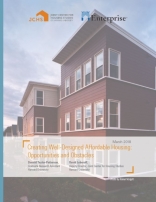CREATING WELL-DESIGNED AFFORDABLE HOUSING: OPPORTUNITIES AND OBSTACLES
How do the notoriously complicated funding and approval processes for affordable housing shape the design of those projects? In particular, are the funding and approval processes so complex that they make it difficult, if not impossible, to incorporate high-quality design into the planning and execution of affordable housing?
This research brief examines these questions in Massachusetts, particularly in greater Boston, where a variety of public, non-profit, and for-profit actors and entities have long been at the forefront of efforts to build well-designed affordable housing. To do so, it draws on three sources of information: (1) a careful review of the guidelines used to allocate the state's annual allotment of federal Low-Income Housing Tax Credits (LIHTC), a key funding source for affordable housing; (2) interviews with 18 leading local experts in the field, a group that included non-profit and for-profit developers, architects, and several current and former public officials; and (3) observations and discussions at the Affordable Housing Design Leadership Institute (AHDLI), an annual event organized by Enterprise Community Partners that brings together non-profit developers and design professionals to discuss how to improve the design of proposed affordable housing projects. However, the research focused on whether and how key actors and processes assessed the design quality of affordable housing developments.

